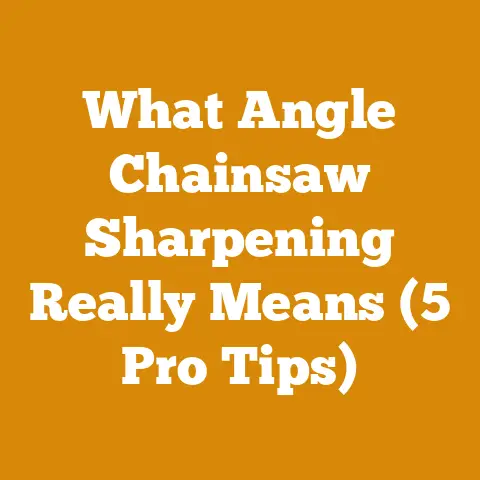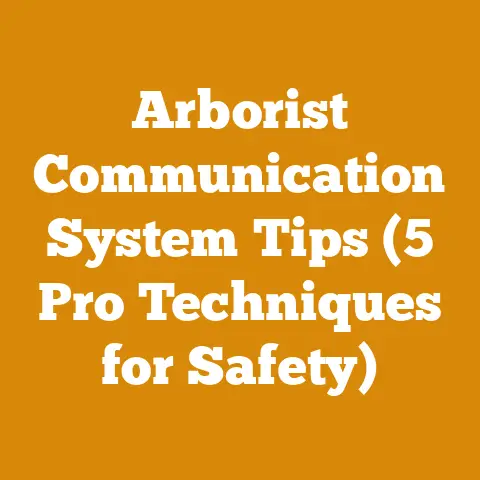Stihl Four Cycle Trimmer: Best Choice for Brush Clearing? (5 Pro Tips)
Imagine a world where little hands, guided by curious eyes, reach out to explore the wonders of nature. My own journey into the realm of wood processing and brush clearing began much like that, fueled by a childhood fascination with the forest behind my house. I remember spending countless hours there, building forts, observing the intricate patterns of tree bark, and dreaming of one day taming the wildness with my own hands. Now, decades later, I still get that childlike thrill when I fire up a chainsaw or a brush trimmer. And if you’re looking to tame some wildness in your own backyard, let me tell you, I’ve got some insights for you.
Today, I want to share my experience with a particular tool that’s become a staple in my arsenal: the Stihl four-cycle trimmer. Is it the best choice for brush clearing? Well, that’s what we’re going to unpack, along with five pro tips that’ll help you make the most of it.
Key Takeaways:
- Four-Cycle Advantages: Understand why a four-cycle engine offers benefits over two-cycle engines in terms of emissions, fuel efficiency, and maintenance.
- Brush Clearing Power: Learn how the Stihl four-cycle trimmer stacks up against other brush clearing tools in terms of power and performance.
- Choosing the Right Model: Discover the key features and specifications to consider when selecting a Stihl four-cycle trimmer for your specific needs.
- Pro Tips for Optimal Use: Get practical advice on everything from proper fuel mixing to maintenance techniques that will extend the life of your trimmer.
- Safety First: Emphasize the importance of safety gear and safe operating procedures to protect yourself while brush clearing.
Stihl Four-Cycle Trimmer: Best Choice for Brush Clearing? Over the years, I’ve used everything from machetes to heavy-duty brush hogs, and I’ve learned that no single tool is perfect for every job. However, the Stihl four-cycle trimmer has consistently impressed me with its versatility, power, and ease of use.
The Allure of Four-Cycle Engines: A Personal Perspective
I’ll be honest, I wasn’t always a fan of four-cycle engines in handheld equipment. I grew up using two-cycle engines, and I was used to the simplicity of mixing oil and gas. But, as environmental regulations tightened and I became more conscious of my own impact, I started to explore alternatives.
The first thing that struck me about the Stihl four-cycle trimmer was the reduced emissions. Compared to a two-cycle engine, a four-cycle engine burns fuel more completely, resulting in significantly lower levels of harmful pollutants. According to the EPA, four-cycle engines can reduce hydrocarbon emissions by as much as 70% compared to their two-cycle counterparts. That’s a huge difference, especially if you’re using the trimmer for extended periods or in areas with sensitive ecosystems.
Beyond the environmental benefits, I also appreciated the improved fuel efficiency. Four-cycle engines are generally more fuel-efficient than two-cycle engines, meaning you can run longer on a single tank of gas. In my own experience, I’ve found that I can get about 25% more run time with my Stihl four-cycle trimmer compared to my old two-cycle model. That translates to fewer trips to the gas station and more time getting the job done.
And then there’s the maintenance. With a two-cycle engine, you have to carefully mix the oil and gas in the correct ratio to avoid damaging the engine. It’s a recipe for disaster! With a four-cycle engine, you simply add gasoline to the fuel tank and oil to the oil reservoir. It’s much simpler and less prone to error. Plus, four-cycle engines tend to run cleaner and require less frequent maintenance than two-cycle engines.
Stihl Four-Cycle Trimmers: Power and Performance
Okay, so four-cycle engines have some clear advantages. But how do Stihl four-cycle trimmers actually perform in the field? In my experience, they deliver plenty of power for most brush clearing tasks.
The key is to choose the right model for your specific needs. Stihl offers a range of four-cycle trimmers, from lightweight models designed for trimming grass and light weeds to more powerful models that can handle heavier brush and small saplings.
I currently use the Stihl FS 91 R. It is equipped with a 28.4 cc engine that delivers plenty of torque for cutting through thick vegetation. I’ve used it to clear everything from overgrown fencerows to dense patches of blackberry bushes, and it has never let me down.
One of the things I appreciate most about the Stihl FS 91 R is its versatility. It can be equipped with a variety of cutting attachments, including trimmer line, metal blades, and even a brush knife. This allows me to customize the trimmer for different types of vegetation and terrain.
For example, when I’m trimming grass around my flower beds, I use the trimmer line attachment. But when I’m clearing brush in the woods, I switch to the metal blade attachment. The metal blade is much more effective at cutting through thick stems and woody vegetation.
Here’s a quick comparison of different cutting attachments and their ideal uses:
- Trimmer Line: Ideal for trimming grass and light weeds around lawns, flower beds, and sidewalks.
- Metal Blade: Ideal for cutting through thicker weeds, brush, and small saplings.
- Brush Knife: Ideal for clearing dense patches of brush and vegetation.
Choosing the Right Stihl Four-Cycle Trimmer: Key Features and Specifications
So, how do you choose the right Stihl four-cycle trimmer for your needs? Here are some key features and specifications to consider:
- Engine Size: The larger the engine, the more power the trimmer will have. If you’re planning on clearing heavy brush, you’ll want to choose a model with a larger engine.
- Weight: Weight is an important consideration, especially if you’ll be using the trimmer for extended periods. Lighter models are easier to maneuver and less fatiguing to use.
- Cutting Width: The cutting width determines how much vegetation the trimmer can cut in a single pass. A wider cutting width will allow you to clear larger areas more quickly.
- Handle Design: The handle design affects the comfort and control of the trimmer. Look for a model with an ergonomic handle that fits comfortably in your hand.
- Vibration Reduction: Vibration can cause fatigue and discomfort, especially when using the trimmer for extended periods. Look for a model with a vibration reduction system.
- Attachment Compatibility: If you plan on using different cutting attachments, make sure the trimmer is compatible with the attachments you need.
To help you narrow down your choices, here are a few popular Stihl four-cycle trimmer models and their ideal uses:
- Stihl FS 56 RC-E: A lightweight and versatile trimmer that’s ideal for homeowners with small to medium-sized yards.
- Stihl FS 91 R: A more powerful trimmer that’s ideal for homeowners and professionals who need to clear heavier brush.
- Stihl FS 111 RX: A high-performance trimmer that’s ideal for professionals who need to clear large areas of dense vegetation.
Remember to consult with a Stihl dealer to get personalized recommendations based on your specific needs and budget.
5 Pro Tips for Optimal Use of Your Stihl Four-Cycle Trimmer
Now that you’ve chosen the right Stihl four-cycle trimmer, it’s time to learn how to use it effectively. Here are five pro tips that will help you get the most out of your trimmer:
- Use the Right Fuel: This might sound obvious, but it’s crucial to use the correct type of fuel in your Stihl four-cycle trimmer. Stihl recommends using premium unleaded gasoline with a minimum octane rating of 89. Avoid using gasoline that contains ethanol, as it can damage the engine. I personally add a fuel stabilizer to every tank of gas to prevent the fuel from going stale.
- Maintain Proper Oil Levels: Unlike two-cycle engines, four-cycle engines have a separate oil reservoir. It’s important to check the oil level regularly and add oil as needed. Stihl recommends using their four-cycle engine oil, which is specifically formulated for their trimmers. I check the oil level before each use and change the oil every 25 hours of operation.
- Sharpen Your Blades Regularly: If you’re using a metal blade attachment, it’s important to keep the blades sharp. Dull blades will make the trimmer work harder and can even damage the engine. I sharpen my blades every few hours of operation using a file or a grinding wheel.
- Clean the Air Filter: A dirty air filter can restrict airflow to the engine, reducing power and fuel efficiency. I clean the air filter every 25 hours of operation using compressed air or a brush.
- Store Your Trimmer Properly: When you’re not using your trimmer, it’s important to store it properly. Drain the fuel tank and run the engine until it stalls. This will prevent the fuel from going stale and damaging the engine. Store the trimmer in a dry, well-ventilated area.
Safety First: Protecting Yourself While Brush Clearing
Before you even think about firing up your Stihl four-cycle trimmer, it’s essential to prioritize safety. Brush clearing can be dangerous work, and it’s important to take precautions to protect yourself from injury.
Here’s a list of essential safety gear:
- Eye Protection: Wear safety glasses or a face shield to protect your eyes from flying debris.
- Hearing Protection: Wear earplugs or earmuffs to protect your hearing from the loud noise of the trimmer.
- Gloves: Wear work gloves to protect your hands from cuts and abrasions.
- Long Pants and Long Sleeves: Wear long pants and long sleeves to protect your skin from scratches and insect bites.
- Steel-Toed Boots: Wear steel-toed boots to protect your feet from falling objects and sharp objects on the ground.
In addition to wearing the proper safety gear, it’s also important to follow these safe operating procedures:
- Read the Owner’s Manual: Before using your Stihl four-cycle trimmer, read the owner’s manual carefully. The manual contains important safety information and operating instructions.
- Inspect the Trimmer: Before each use, inspect the trimmer for any damage or wear. Make sure all the parts are properly assembled and that the cutting attachment is securely attached.
- Clear the Area: Before starting the trimmer, clear the area of any obstacles, such as rocks, branches, and debris.
- Maintain a Safe Distance: Keep a safe distance from other people and animals while operating the trimmer.
- Use Proper Technique: Use a smooth, sweeping motion when cutting vegetation. Avoid jerking or forcing the trimmer.
- Take Breaks: If you’re using the trimmer for extended periods, take frequent breaks to avoid fatigue.
Real-World Example: Clearing a Neglected Property Line
I recently had a project that really put my Stihl FS 91 R to the test. A client had purchased a property with a severely overgrown property line. It was a tangled mess of blackberry bushes, poison ivy, and small saplings. The previous owner had clearly neglected the area for years.
I started by using the metal blade attachment to cut through the thicker brush and saplings. The Stihl FS 91 R powered through the vegetation with ease. I was impressed by how quickly I was able to clear a path along the property line.
Once I had cleared the bulk of the vegetation, I switched to the trimmer line attachment to clean up the edges and trim the grass. The trimmer line was perfect for getting into tight spaces and around obstacles.
The entire project took me about eight hours to complete, but the results were dramatic. The property line was clearly defined, and the client was thrilled with the transformation.
This project really highlighted the versatility and power of the Stihl FS 91 R. It’s a tool that I can rely on to get the job done, no matter how challenging the conditions.
Conclusion: Is the Stihl Four-Cycle Trimmer Right for You?
So, is the Stihl four-cycle trimmer the best choice for brush clearing? The answer, as with most things, is it depends.
If you’re looking for a versatile, powerful, and environmentally friendly trimmer that can handle a wide range of brush clearing tasks, then the Stihl four-cycle trimmer is definitely worth considering. However, if you’re only planning on trimming grass and light weeds, then a less powerful (and less expensive) trimmer might be a better option.
Ultimately, the best way to decide if a Stihl four-cycle trimmer is right for you is to try one out for yourself. Visit your local Stihl dealer and ask for a demonstration. See how it feels in your hands and how it performs in the field.
And remember, safety should always be your top priority. Wear the proper safety gear and follow safe operating procedures to protect yourself from injury.
With the right tool and the right techniques, you can tackle even the most challenging brush clearing projects. So get out there and tame that wildness!
I hope this article has been helpful. If you have any questions or comments, please feel free to leave them below. And if you’re looking for more tips and advice on wood processing and brush clearing, be sure to check out my other articles. Happy clearing!






